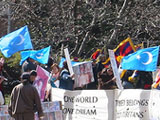Costs of War: Uighur Dilemma
By Shaun Waterman for ISN
Rioting Sunday night in the region’s capital Urumqi has external pageleft more than 150 dead and over 1,000 injuredcall_made, according to Beijing’s official news agency Xinhua. US Radio Free Asia said that the external pageviolence was sparked by angercall_made at the external pagekillings last month of at least two Uighur migrant workerscall_made in southern China by a mob of majority Han Chinese.
Xinhua said external page20,000 police armed with tear gascall_made, stun grenades and high-pressure water hoses had been deployed to quell the violence and reported a tense calm on the streets of Urumqi.
The state news agency also reported that more than external page1,400 people had been arrestedcall_made, including some accused of plotting further violence in other towns in the province, known as the Xinjiang-Uighur Autonomous Region. Authorities also shut down external pageaccess in Urumqi to the internetcall_made - which was being used to spread word of the protests - according to Reuters news agency. Users of the popular micro-blogging service Twitter.com in the rest of China also reported that it was external pageunavailablecall_made.
The Wall Street Journal quoted hospital officials as saying that the large majority of those injured in the violence were external pageHan Chinese beaten and stabbed by rioterscall_made, and state television showed pictures of mobs burning police and public transit vehicles.
external pageXinhua linked the violent protestscall_made with what Chinese officials say is a series of terrorist plots and attacks by Uighur separatists over the past two and half years, and drew immediate parallels with the violence in Lhasa in March last year, when Tibetan mobs fought with police and attacked Han Chinese-owned businesses.
The vast Xinjiang region - one-sixth of the entire landmass of China - is sometimes referred to as ‘China’s other Tibet.’ Like Tibet, the region has seen increasing, state-sponsored settlement by Han Chinese, which has reduced the Turkic-speaking Uighurs, most of whom are Muslims, to just about 45 percent of the region’s nearly 20 million inhabitants. Many Uighurs see Han immigration as a threat to their traditional identity, but any efforts at political or religious self-organization have been stamped out by Beijing, which, according to Human Rights Watch, operates "a multi-tiered system of surveillance, control, and suppression of religious activity.”
The group says that "The harshest punishments are meted out to those accused of involvement in separatist activity, which is increasingly equated by officials with 'terrorism'." That equivalence was on display in official accounts of the violence this week.
“The three forces of terrorism, separatism and extremism are at work again,” read a external pageXinhua commentarycall_made, blaming the “premeditated and organized” violence on a diaspora organization, the World Uighur Congress.
The congress external pagedenied any rolecall_made in the violence. “It is a common practice of the Chinese government to accuse me for any unrest in East Turkestan and His Holiness the Dalai Lama for any unrest in Tibet,” said its leader Rebiya Kadeer, using the group’s preferred nomenclature for the region.
White House Spokesman Robert Gibbs said in a external pagestatementcall_made that it would be “premature to comment or speculate” on the causes of the violence, adding, “We call on all in Xinjiang to exercise restraint.”
State Department Spokesman Ian Kelley external pagereiteratedcall_made that line to reporters Monday, declining efforts to draw him into a condemnation of the Chinese crackdown.
Part of the problem for US officials is that Washington has, in the eyes of some commentators, abetted Beijing’s efforts to equate Uighur separatism with terrorism. Among the detainees Obama is releasing from the military jail at Guantanamo bay are 17 Uighurs, held there since their capture in Afghanistan in 2002.
In that year, as part of the Bush administration’s efforts to internationalize its war on terrorism, the US State Department added the East Turkestan Islamic Movement - a small Uighur separatist group - to its list of foreign terrorist organizations.
external pageAccording to the Council on Foreign Relationscall_made, US officials said that the group received “training and funding” from al-Qaida and that its militants fought with them against US troops in Afghanistan. But critics have suggested that listing the group was an effort to cozy up to Beijing.
There is little doubt that there are some Islamic extremist supporters of al-Qaida among the Uighur diaspora. Hizb-e Islami Turkestan, the Turkestan Islamic Party (TIP), for instance, produces an external pageArabic-language internet magazinecall_made distributed by al-Qaida websites - although it is clear that the intended audience for the publication is external pageunlikely to be Uighurscall_made, most of whom cannot speak Arabic.
Last year, TIP claimed responsibility for what Chinese authorities said was a series of terrorist attacks and threats apparently aimed at disrupting the Beijing Olympics, but it is unclear what their relationship - if any - is to the ETIM, which some say is now defunct.
In its efforts to re-frame its predecessor’s campaign against al-Qaida, the Obama administration will have to deal with the fact that Islamic extremists in Xinjiang - like the Muslim Brotherhood in Egypt - may turn out to be among those demanding what Kelly on Monday called the “external pagerestoration of personal freedomscall_made.” “We do stand with them,” Kelly said. But he did not - and indeed probably could not - say who “them” was.

